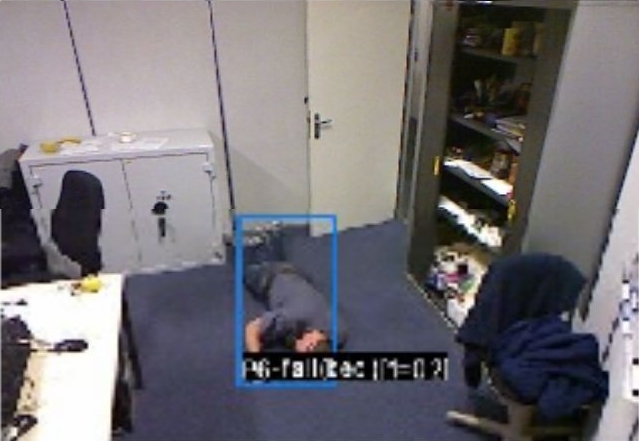Section: New Results
Detecting Falling People
Participants : Etienne Corvee, Francois Bremond.
keywords: fall, tracking, event
We have developed a people falling algorithm based on our object detection and tracking algorithm [58] and using our ontology based event detector [57] . These algorithms extract moving object trajectories from videos and triggers alarms whenever the people activity fits event models. Most surveillance systems use a multi Gaussian technique [83] to model background scene pixels. This technique is very efficient in detecting in real-time moving objects in scenes captured by a static camera, with low level of shadows, few persons interacting in the scene and with as few as possible illumination changes. This technique does not analyse the content of the moving pixels but simply assign them as foreground or background pixels.
Many state of the art algorithms exist that can recognize objects such as a person human shape, a head, a face or a couch. However, these algorithms are quite time consuming or the database used for training the system is not well adapted to our application domain. For example, people detection algorithms use databases containing thousands of image instances of standing or walking persons taken by camera from a certain distance from the persons and from a facing position. In our indoor monitoring application, cameras are located on the roof with high tilt angle so that most of the scene (e.g.rooms) is viewed. With such camera spatial configuration, the image of a person on the screen rarely corresponds to the person images in the training database. In addition, people are often occluded by the image border (the image of the full body is not available), image distortion needs to be corrected and people often have poses that are not present in the database (e.g. a person bending or sitting).
Using our multi Gaussian technique [74] , after having calibrated a camera scene, a detected object is associated with a 3D width and height in two positions : the standing and lying positions. This 3D information is checked against 3D human model and any object is then labelled as either a standing person, a lying person or unknown. Many 3D filtering thresholds are used ; for example, object speed should not be greater than a human possible running speed. Second, we use an ontology based event detector to build a hierarchy of event model complexity. We detect people to have fallen on the floor if the object has been detected as a person on the floor and outside the bed and couch for at least several seconds consecutively. An example of a fallen person is shown in Figure 24 .



